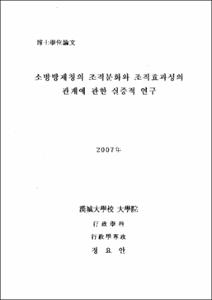소방방재청의 조직문화와 조직효과성의 관계에 관한 실증적 연구
- Files in This Item:
-
-
Download
 000000557042.pdf
기타 데이터 / 5.18 MB / Adobe PDF
000000557042.pdf
기타 데이터 / 5.18 MB / Adobe PDF
-
Items in Repository are protected by copyright, with all rights reserved, unless otherwise indicated.
 000000557042.pdf
기타 데이터 / 5.18 MB / Adobe PDF
000000557042.pdf
기타 데이터 / 5.18 MB / Adobe PDFItems in Repository are protected by copyright, with all rights reserved, unless otherwise indicated.